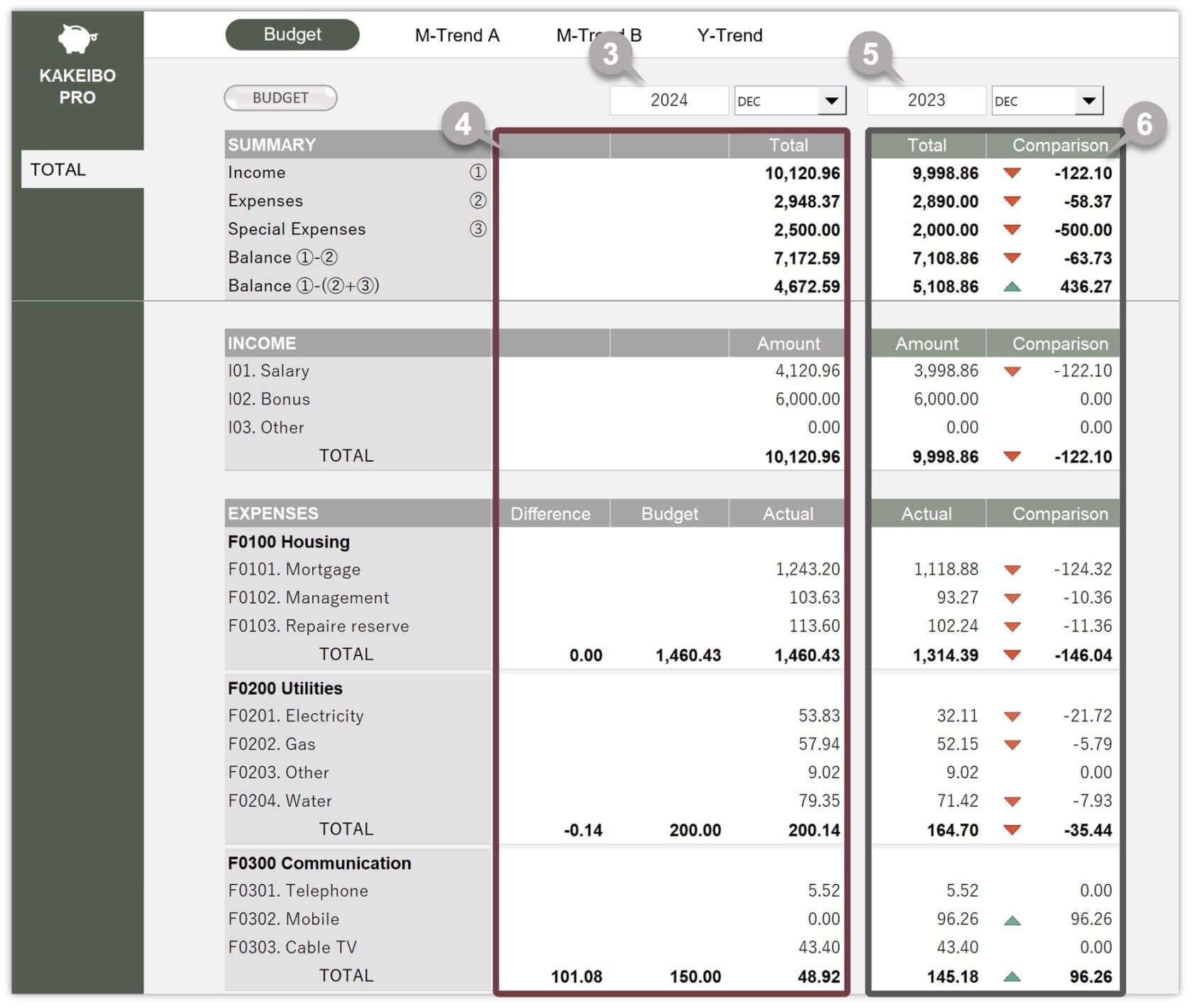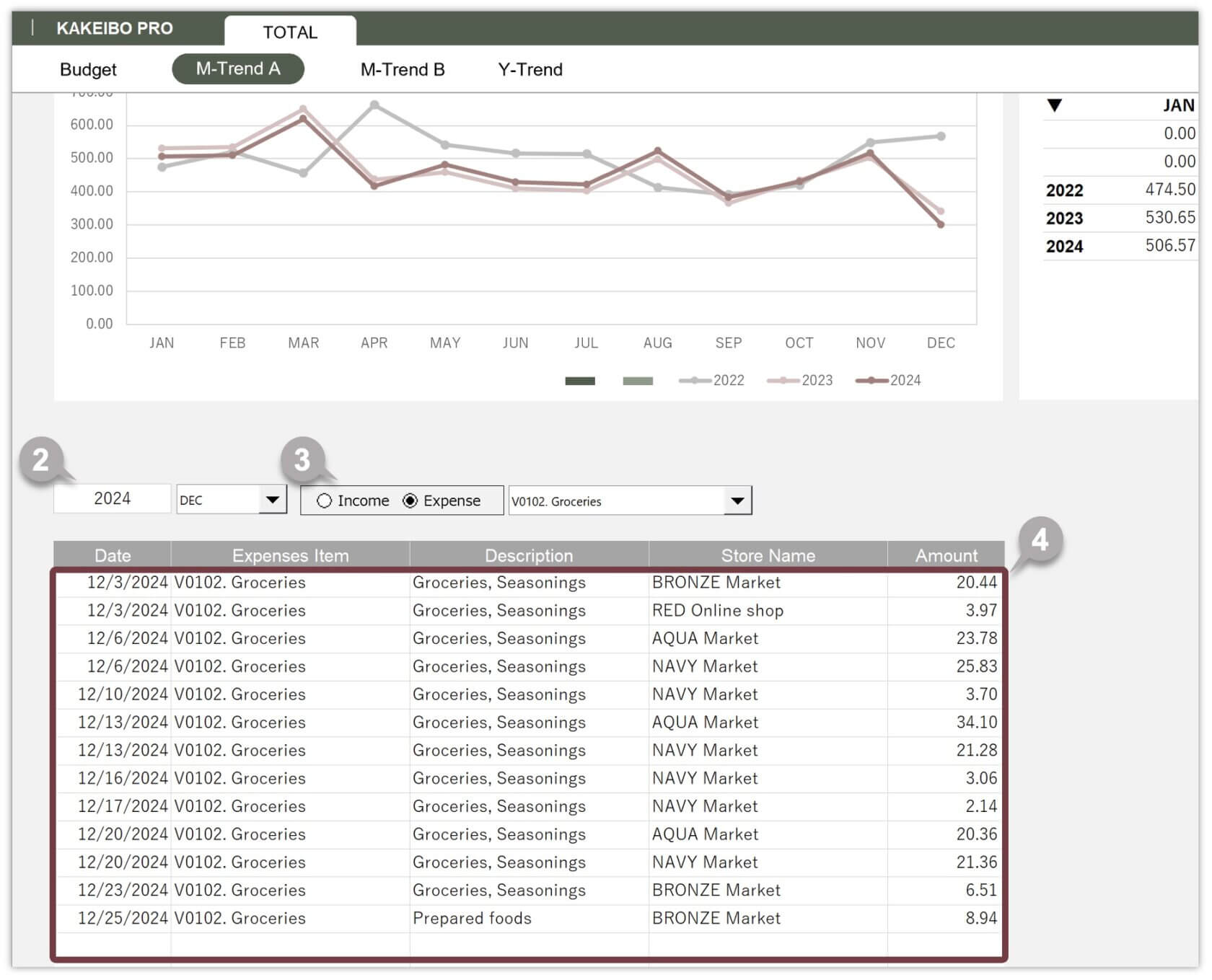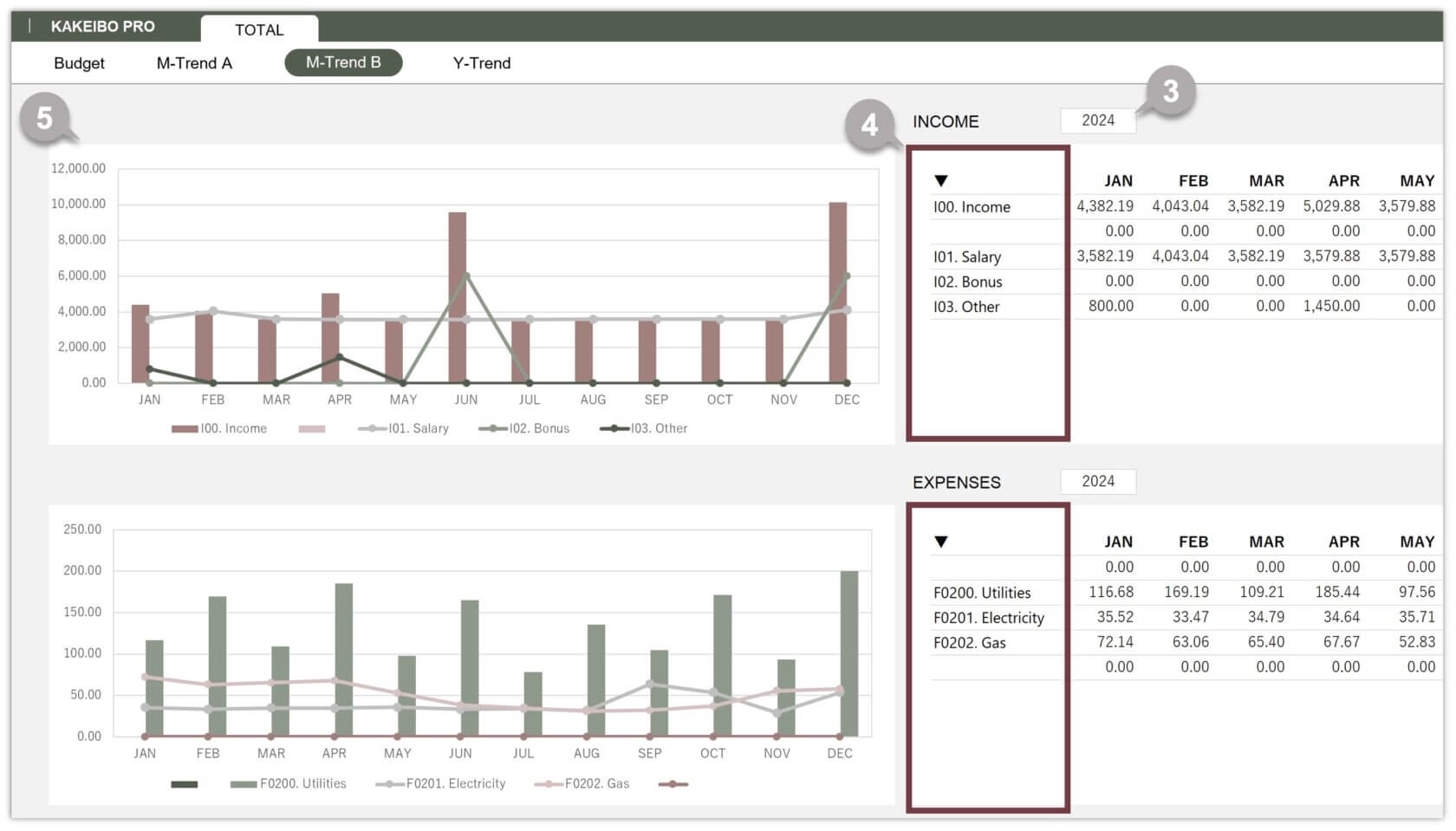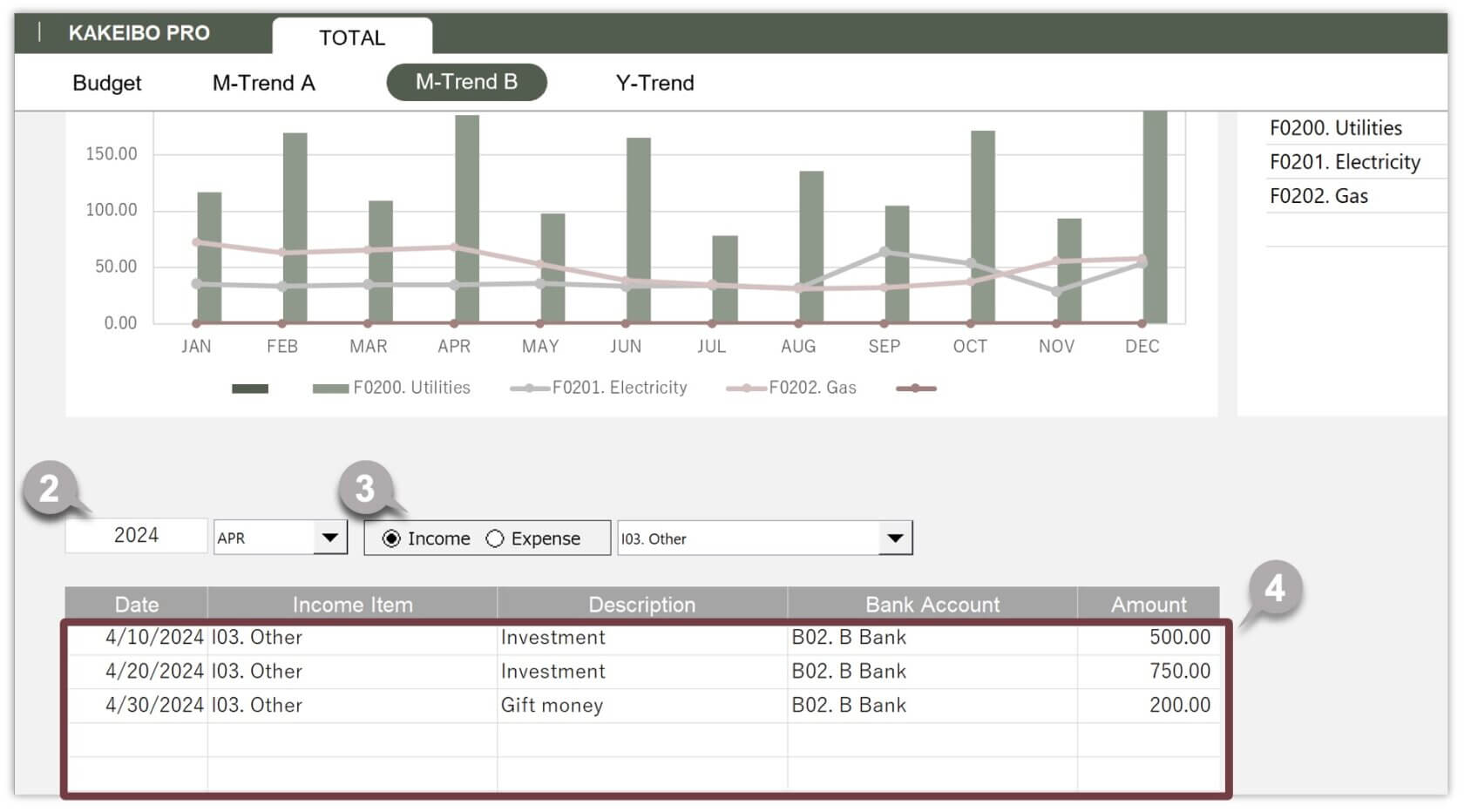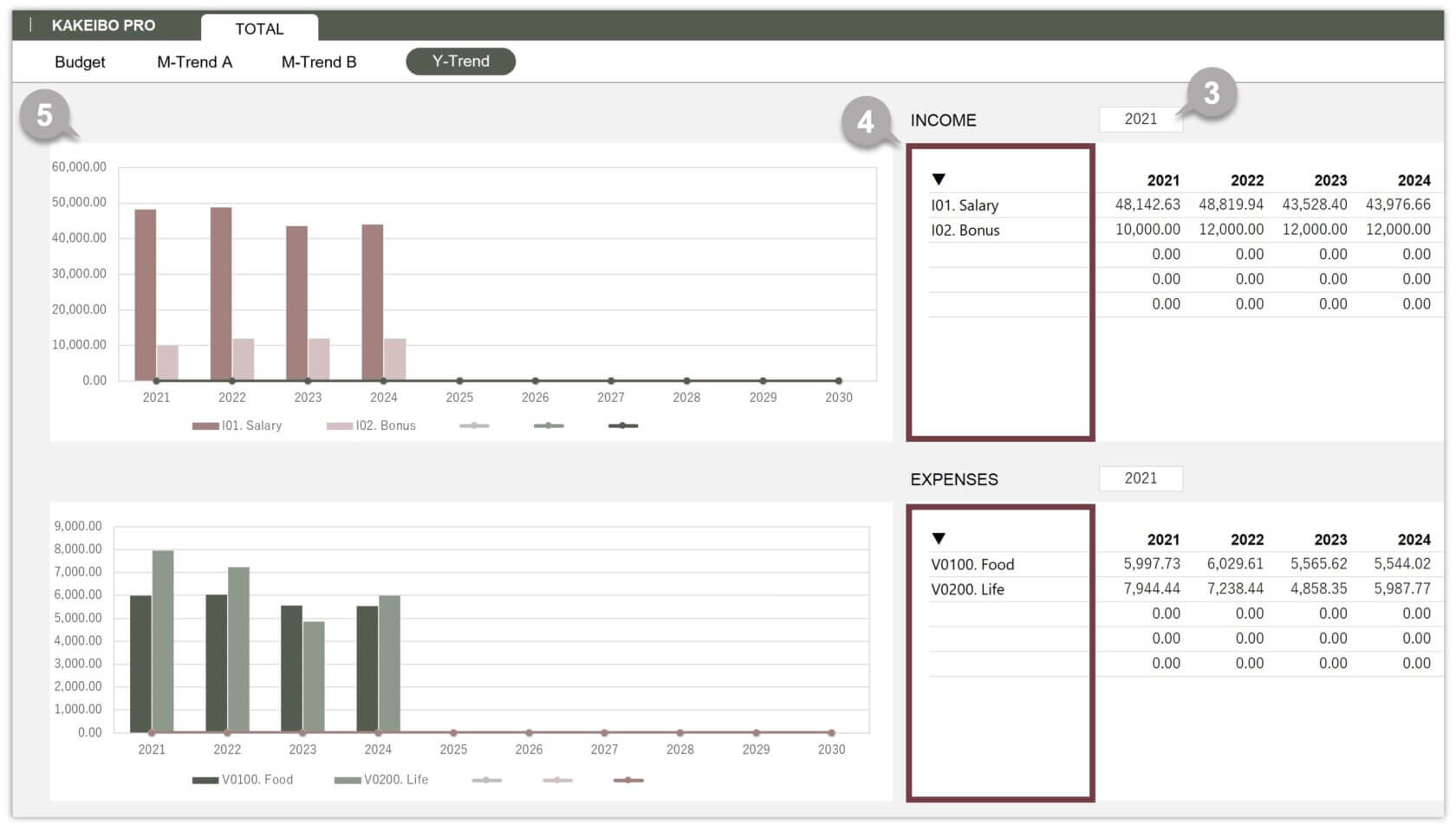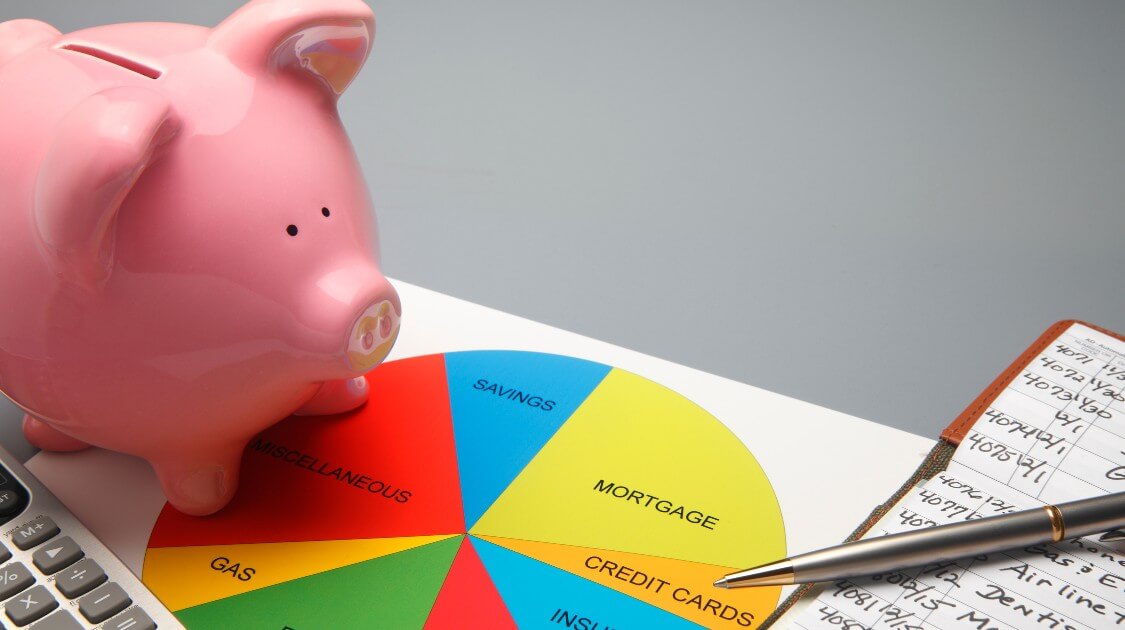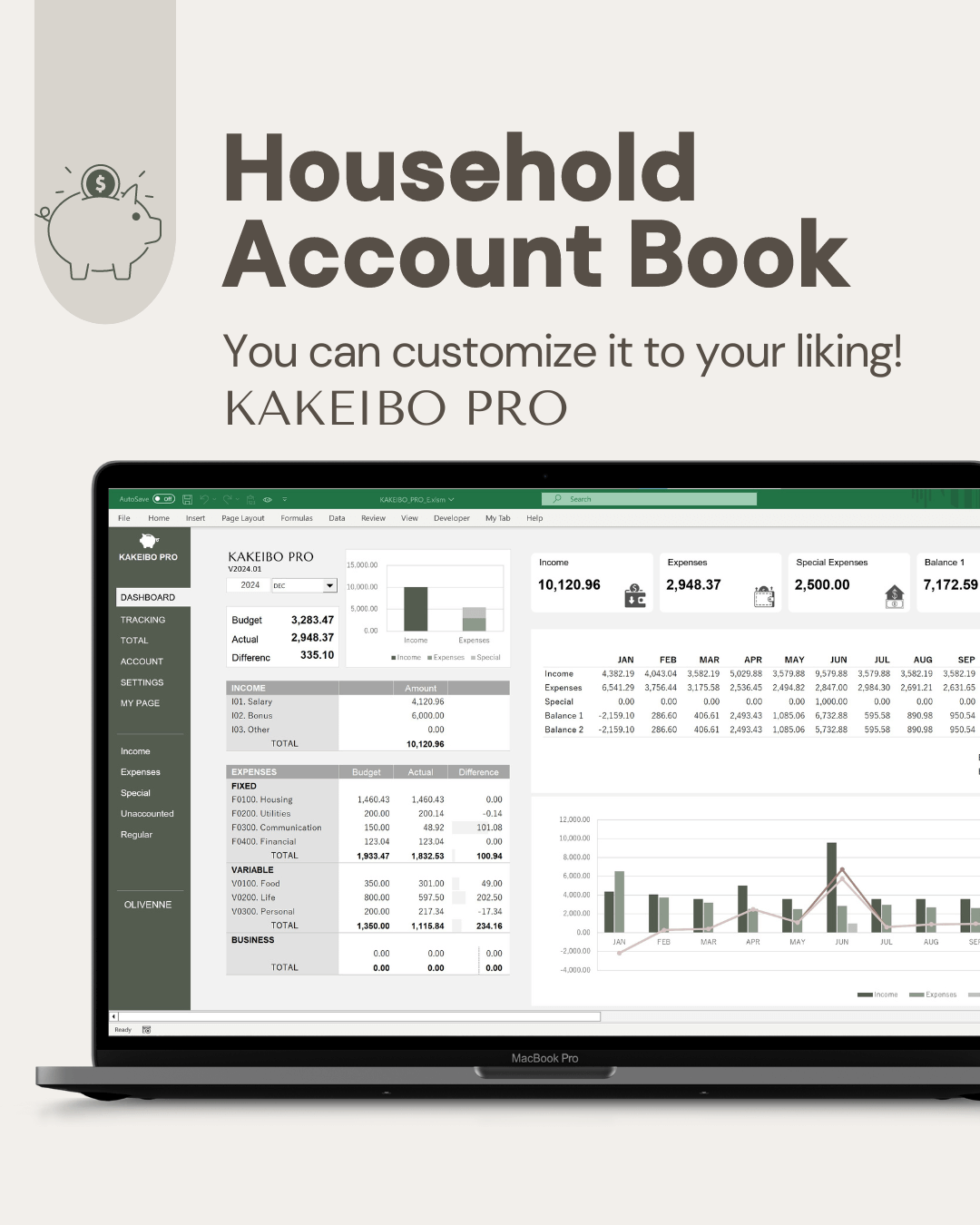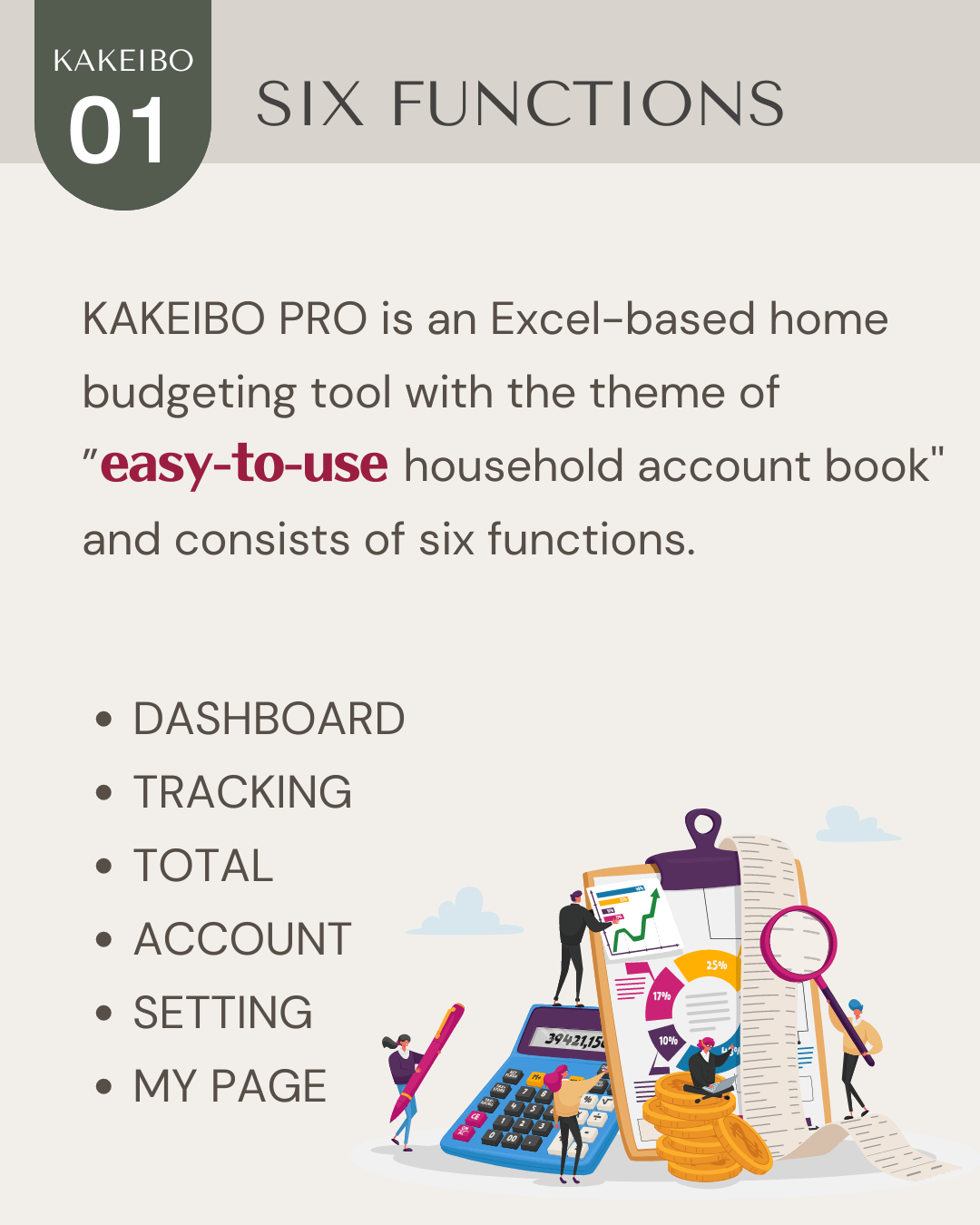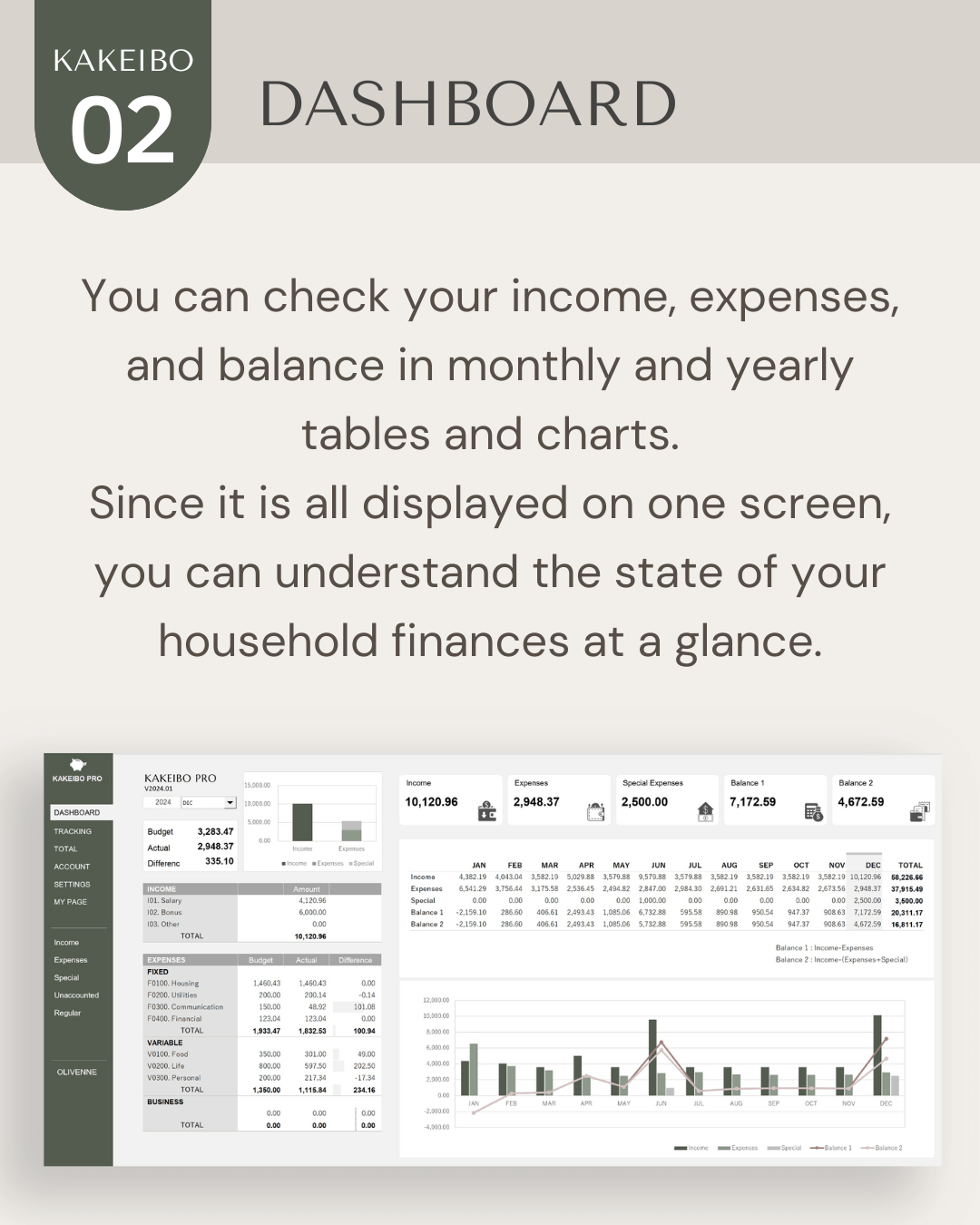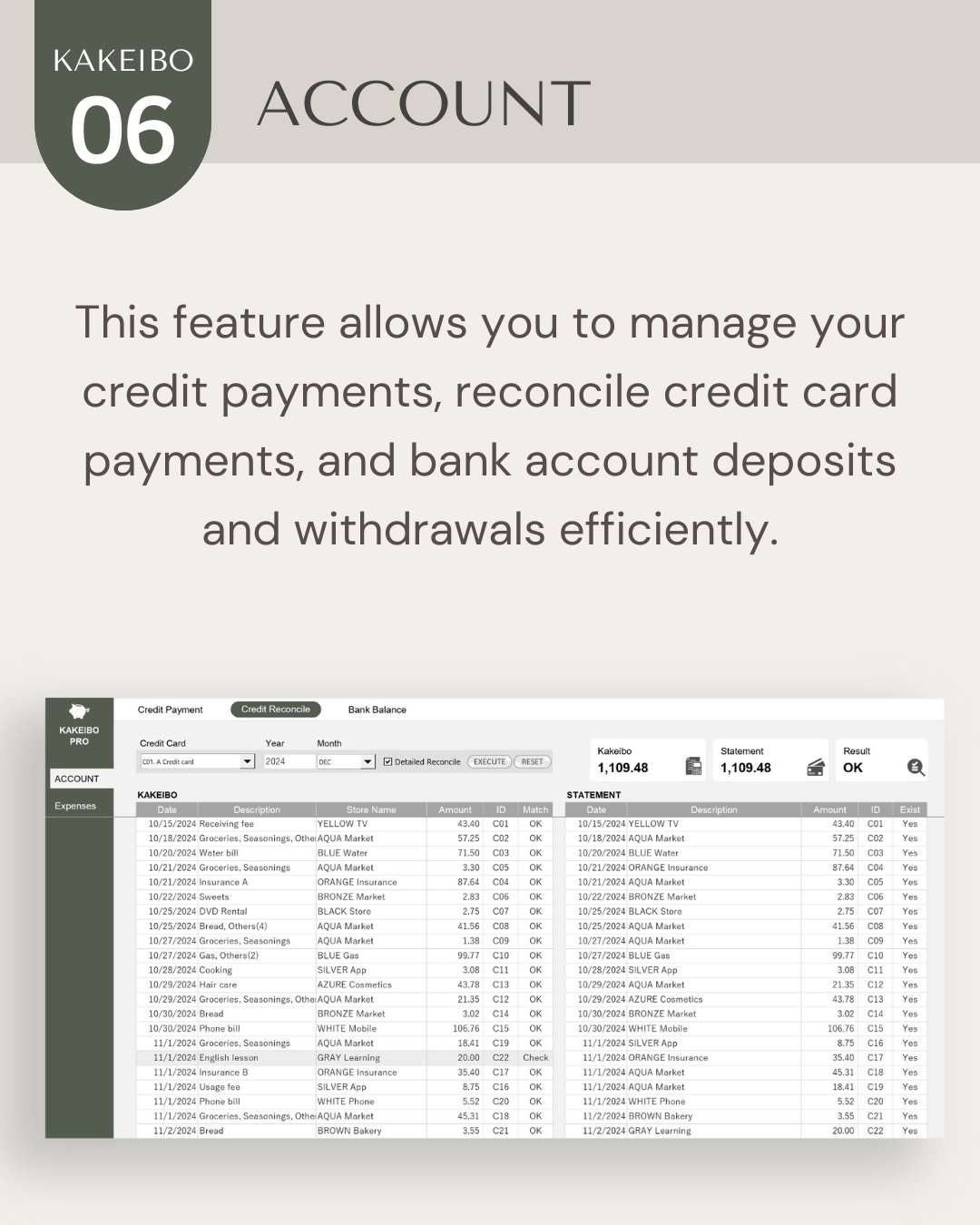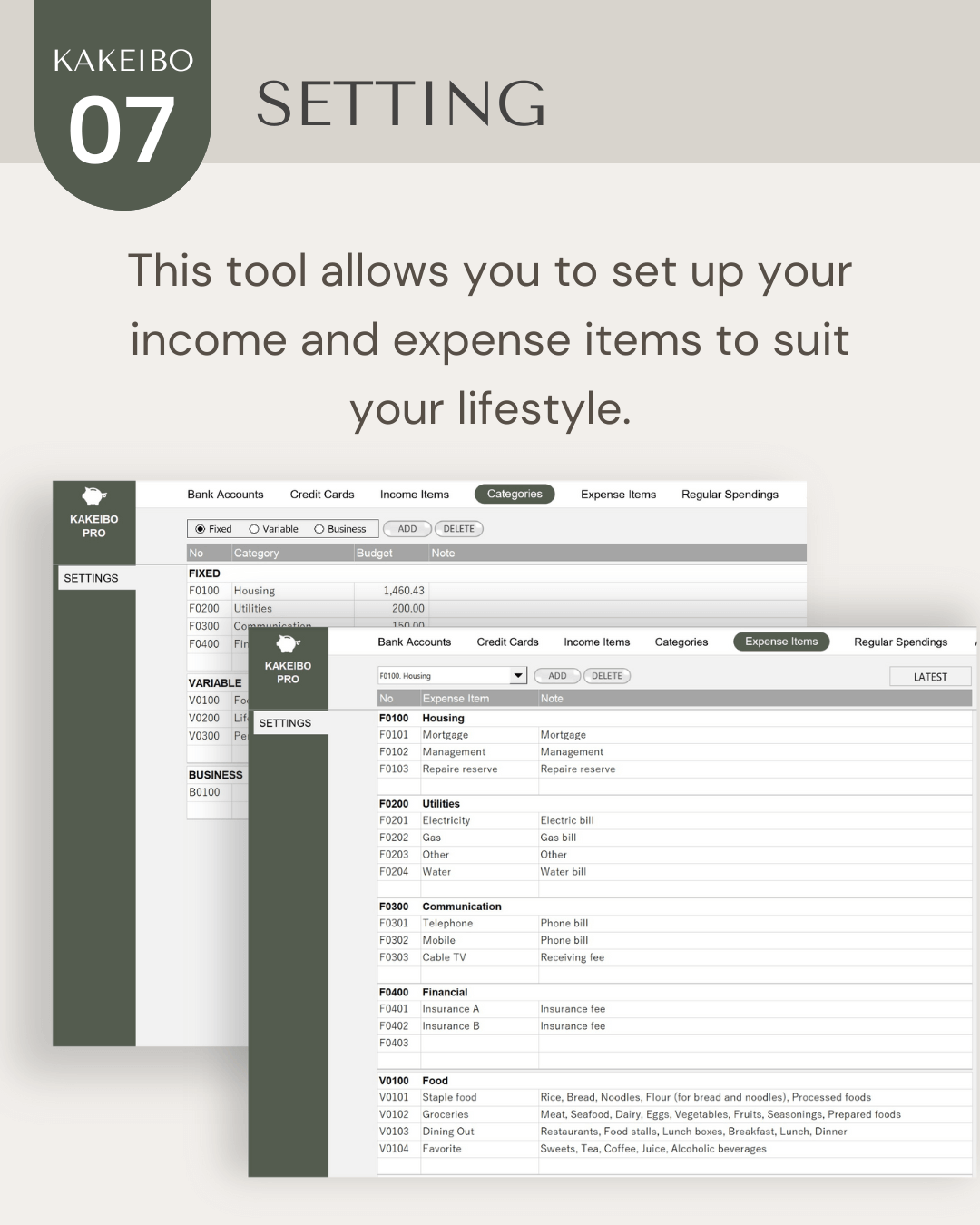Excel home budgeting tool for hassle-free household budget management!
KAKEIBO PRO and KAKEIBO LiGHT automatically aggregate income and expense data, allowing you to view monthly and annual tabulation table at a glance. Since there is no need for tedious manual work, you can quickly grasp the health and trends of your household finances. In addition, with the dashboard and trend analysis functions, you can view aggregated values in tables and charts, allowing you to analyze your household finances from various perspectives.
The auto-tabulation features allow you to save time and more accurate analysis of your household finances to help you manage your finances in a planned manner. This guide shows you the features of dashboard, budgeting, and trend analysis.
Language: English Japanese
–
1. Dashboard
When you launch the tool, you will first see the dashboard. You can view your income, expenses, and balances in monthly and yearly tables and charts. Since it displays all the information on one screen, you can understand your household finances at a glance.
A Specify the Year and Month
Specify the target year and month. It automatically calculates the data in the dashboard, and you can view the total values for the specified year and month in tables and charts.
B Budget vs. Actual Expenses
It displays the monthly total of budget, actual expenses, and difference (budget – actual expenses) for the specified year and month. You can easily compare the set budget with actual expenses. Any deviation from the budget can be immediately noticed and you can make necessary adjustments.
C Income vs. Expenses
It displays the monthly total of income and expenses for the specified year and month in a bar chart. The graphical visualization makes it easy to check whether expenses are higher than income.
D Monthly Total of Income
It totals the income by item for the specified year and month.
E Monthly Total of Expenses and Budget Management
It aggregates the expenses by category for the specified year and month. It allows you to view the difference between budgeted and actual expenditures in the data bar, so you can quickly grasp how much you are spending against the budget. As actual expenses increase, the data bar becomes smaller. We want to make sure that the data bar will still be there at the end of the month!
F Summary
It displays the monthly total of income, expenses, special expenses, and balance for the specified year and month in a list. The large font makes it extremely easy to read.
G Trend Tracking
It aggregates income, expenses, special expenses, and balances for the specified year on a monthly basis, and you can view them in a yearly table and graph. In the annual tally table, it highlights the specified month. Since it visualizes the aggregated values as bar charts and line charts, you can easily track patterns and changes over time.
Balance 1 and Balance 2
Balance 1 is the amount of income subtracted from normal expenses: [Income – Expenses]. Balance 2 is the amount of income subtracted from expenses including special expenses: [Income – (Expenses + Special Expenses)]
–
2. Budget Management
The tool aggregates the daily details by item, allowing you to easily view monthly income and expenses. You can also specify a year and month, then compare the balance with that month. It allows you to set a budget for each category. It provides you with a detailed side-by-side comparison of your projected monthly budget vs. your actual expenses. This summary provides you with a quick and straightforward way to identify where you may be overspending. Eliminate waste and manage your household finances in a well-planned manner! Here are the steps to how to use the budget management:
1 Click on TOTAL in the main menu.
2 Click on Budget under the TOTAL group.
3 Enter the target year and select the month from the drop-down list.
4 It will display the aggregated values for the specified year and month.
Compare with a Specific Year and Month
5 Enter the target year and select the month from the drop-down list for comparison.
6 It will display the aggregated values for the specified year and month. In the Comparison column, it allows you to view the value compared to the current month: [The specific year and month – The current month].
Edit the Budget
To edit the budget, click the BUDGET button. The Categories sheet will appear, and enter the amount in the Budget column.
–
3. Trend Analysis
You can check the aggregated values in tables and charts, allowing you to analyze your household finances from various perspectives. In addition, the filter function allows you to quickly check detailed data in outstanding areas on the graph. This tool provides three analysis sheets: Monthly trend A, Monthly trend B, and Annual trend.
3-1. Monthly Trend A
In the M-Trend A sheet, you can compare the trends of the specified item for up to five different years. You can also specify two items and compare the pattern of each trend. Here are the steps to how to use it:
1 Click on TOTAL in the main menu.
2 Click on M-Trend A under the TOTAL group.
3 Choose Income or Expense, then select the target item from the drop-down list.
4 Enter the target year. You can specify up to five years.
5 It will display the monthly trends for the specified item.
Bar and Line Charts
It displays the data specified in the first and second rows of the table as bar charts, the data specified in the third through fifth rows as line charts. For example, you can use a bar chart to display the base year and a line chart to display the year for comparing against the base one.
Extract data with Filter Function
You can extract specific item data from income or expense details. To extract detailed data, follow these steps:
1 Scroll down the screen.
2 Enter the target year and select the month from the drop-down list.
3 Choose Income or Expense, and then select the target item from the drop-down list.
4 It will display the details that match the specified criteria.
3-2. Monthly Trend B
In the M-Trend B sheet, you can view the monthly trends of up to five items in bar and line charts. This function is useful for understanding how each item is trending over time. Here are the steps to how to use it:
1 Click on TOTAL in the main menu.
2 Click on M-Trend B under the TOTAL group.
3 Enter the target year.
4 Select the target item from the drop-down list. You can specify up to five items.
5 It will display the monthly trends for the specified items.
Bar and Line Charts
It displays the data specified in the first and second rows of the table as bar charts, the data specified in the third through fifth rows as line charts. For example, you can display the utility costs as a bar chart, and electricity, gas, and water as line charts. This makes it easy to see how much electricity, gas, and water are in comparison to the utility costs.
Extract data with Filter Function
You can extract specific item data from income or expense details. To extract detailed data, follow these steps:
1 Scroll down the screen.
2 Enter the target year and select the month from the drop-down list.
3 Choose Income or Expense, and then select the target item from the drop-down list.
4 It will display the details that match the specified criteria.
3-3. Annual Trend
In the Y-Trend sheet, you can view the annual trends of up to five items in bar and line charts. This feature is useful for understanding the long-term trend of household finances. Here are the steps to how to use it:
1 Click on TOTAL in the main menu.
2 Click on Y-Trend under the TOTAL group.
3 Enter the starting year.
4 Select the target item from the drop-down list. You can specify up to five items.
5 It will display the annual trends for the specified items.
Bar and Line Charts
It displays the data specified in the first and second rows of the table as bar charts, the data specified in the third through fifth rows as line charts. For example, if there is data for less than 10 years, you can display data as bar charts. If there is data for more than 10 years, you can display data as line charts.
Extract data with Filter Function
You can extract specific item data from income or expense details. To extract detailed data, follow these steps:
1 Scroll down the screen.
2 Enter the target year.
3 Choose Income or Expense, and then select the target item from the drop-down list.
4 It will display the details that match the specified criteria.
FILTER function
This tool uses the FILTER function to extract data; the FILTER function is available for Microsoft 365 and Excel 2021 or later versions. For more information, see the Microsoft Support page.

